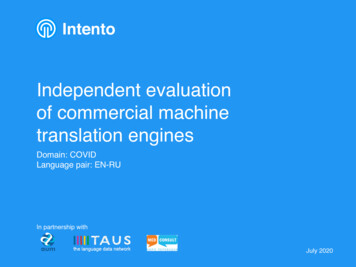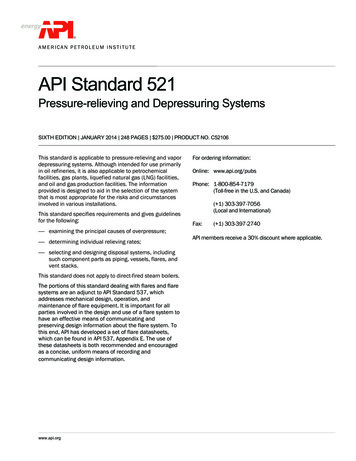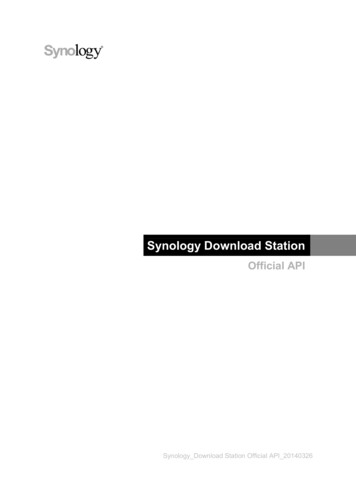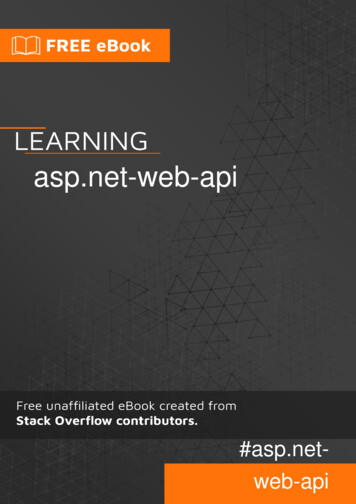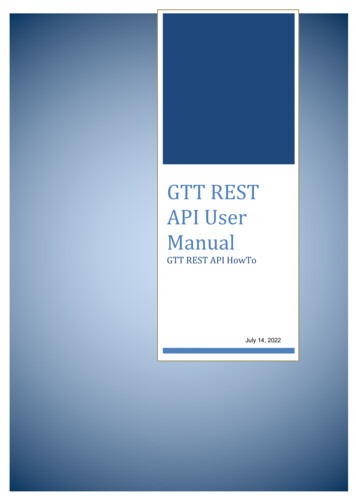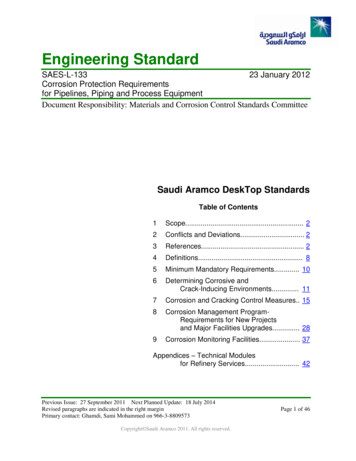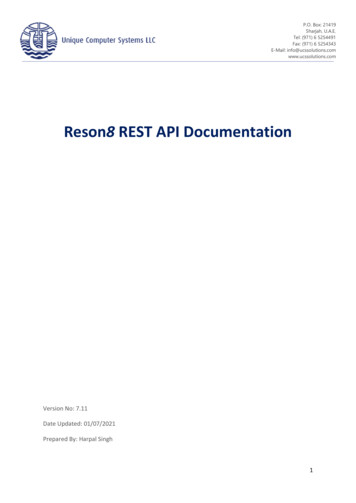
Transcription
Lecture 2: System Calls &API Standards
Contents AE4B33OSSOS structureSystem call – implementation and typesAPI StandardsProcess Control CallsMemory Management CallsFile Access CallsFile & Directory Management CallsOther CallsPOSIX and Win32 ComparisonThe concept of ProcessProcess states and life-cycleCPU SchedulingLecture 3 / Page 2Silberschatz, Galvin and Gagne 2005
Structure of computerUserApplicationdeveloperOS developerApplicationsSystem programs (utility)Operating system kernelHardwareAE4B33OSSLecture 3 / Page 3Silberschatz, Galvin and Gagne 2005
System Programs System programs provide a convenient environmentfor program development and execution. The can bedivided into: File manipulationStatus informationFile modificationProgramming language supportProgram loading and executionCommunicationsApplication programs Most users view the operation system by theservices defined by system programs, not theactual system calls system calls form the programmer’s viewAE4B33OSSLecture 3 / Page 4Silberschatz, Galvin and Gagne 2005
System Programs File modification Text editors to create and modify files Special commands to search contents of files or performtransformations of the text Programming-language support – Compilers,assemblers, debuggers and interpreters sometimesprovided Program loading and execution – linkage editors, absolute loaders, relocatable loaders and overlay-loaders, debugging systems for higher-level and machine language Communications - Provide the mechanism for creatingvirtual connections among processes, users, andcomputer systemsAE4B33OSS Allow users to send messages to one another’s screens,browse web pages, send electronic-mail messages, log inremotely, transfer filesfrom one machine to anotherSilberschatz, Galvin and Gagne 2005Lecture 3 / Page 5
OS structureAE4B33OSSLecture 3 / Page 6Silberschatz, Galvin and Gagne 2005
UNIX System StructureAE4B33OSSLecture 3 / Page 7Silberschatz, Galvin and Gagne 2005
Microkernel System Structure Moves as much from the kernel into “user” space Communication takes place between user modulesusing message passing Benefits: Easier to extend a microkernelEasier to port the operating system to new architecturesMore reliable (less code is running in kernel mode)More secure Detriments: Performance overhead of user space to kernel spacecommunicationAE4B33OSSLecture 3 / Page 8Silberschatz, Galvin and Gagne 2005
Windows NT - XPAE4B33OSSLecture 3 / Page 9Silberschatz, Galvin and Gagne 2005
System Calls Programming interface to the services provided by theOS Typically written in a higher-level language (C or C ) Mostly accessed by programs via a higher-levelApplication Program Interface (API) rather thandirect system call use Direct system call need low-level programming,generally in assembler. User need to know targetarchitecture cannot create CPU independent code. Higher-level languages make easy to use system callsand define system call behavior.AE4B33OSSLecture 3 / Page 10Silberschatz, Galvin and Gagne 2005
API – System Call Implementation The interface to the services provided by theOS has two parts:1.2.Higher language interface – a part of asystem library Executes in user mode Implemented to accept a standardprocedure call Traps to the Part 2Kernel part Executes in system mode Implements the system service May cause blocking the caller (forcingit to wait) After completion returns back to user(report the success or failure of the call)AE4B33OSSLecture 3 / Page 11Silberschatz, Galvin and Gagne 2005
How the System Call Interface is ImplementedX86 System Call Example Hello World on Linux.section .rodatagreeting:.string "Hello World\n".textstart:mov 12,%edxmov greeting,%ecxmov 1,%ebxmov 4,%eaxint 0x80/* write(1, "Hello World\n", 12) *//* write is syscall no. 4 */xorl %ebx, %ebxmov 0xfc,%eaxint 0x80/* Set exit status and exit */hlt/* Just in case. */AE4B33OSSLecture 3 / Page 12Silberschatz, Galvin and Gagne 2005
System Call Implementation Typically, a number associated with each system call System-call interface maintains a table indexed according tothese numbers The system call interface invokes intended system callin OS kernel and returns status of the system call andany return values The caller need know nothing about how the systemcall is implemented Just needs to obey API and understand what OS will do as aresult call Most details of OS interface hidden from programmer by API Managed by run-time support library (set of functions built intolibraries included with compiler)AE4B33OSSLecture 3 / Page 13Silberschatz, Galvin and Gagne 2005
Standard C Library Example C program invoking printf() library call, which callswrite() system callAE4B33OSSLecture 3 / Page 14Silberschatz, Galvin and Gagne 2005
System API Standards Three most common API standards are POSIX API for POSIX-based systems (including virtually allversions of UNIX, Linux, and Mac OS X) Win32 API for Windows Java API for the Java virtual machine (JVM) out of this course scope POSIX (IEEE 1003.1, ISO/IEC 9945) Very widely used standard based on (and including) C-language Defines both system calls and compulsory system programs together with their functionality andcommand-line format– E.g. ls –w dir prints the list of files in a directory in a ‘wide’ format Complete specification is frame.html Win32 (Micro oft Windows based systems) Specifies system calls together with many Windows GUI routines VERY complex, no really complete specificationAE4B33OSSLecture 3 / Page 15Silberschatz, Galvin and Gagne 2005
POSIX Portable Operating System Interface for Unix – IEEEstandard for system interface Standardization process began circa 1985 –necessary for system interoperability 1988 POSIX 1 Core services 1992 POSIX 2 Shell and utilities 1993 POSIX 1b Real-time extension 1995 POSIX 1c Thread extension After 1997 connected with ISO leads to POSIX:2001and POSIX:2008 33OSSLecture 3 / Page 16Silberschatz, Galvin and Gagne 2005
POSIX example Standard defines:Name - system call name(for example read)Synopsis - ssize t read(int fildes, void *buf, size t nbyte);Description – detailed text description of system call functionsReturn value – define all possible return values, oftendescribes how to recognize errors Errors – define all possible errors of this function Examples – sometimes are listed examples how to use thiscall See also – list of systems calls related to described systemcall AE4B33OSSLecture 3 / Page 17Silberschatz, Galvin and Gagne 2005
POSIX exampleNAMEabort - generate an abnormal process abort SYNOPSIS#include stdlib.h void abort(void);DESCRIPTION[CX]The functionality described on this reference page is aligned with the ISO Cstandard. Any conflict between the requirements described here and the ISO Cstandard is unintentional. This volume of POSIX.1-2008 defers to the ISO Cstandard.The abort() function shall cause abnormal process termination to occur, unless thesignal SIGABRT is being caught and the signal handler does not return.[CX]The abnormal termination processing shall include the default actions defined forSIGABRT and may include an attempt to effect fclose() on all open streams.The SIGABRT signal shall be sent to the calling process as if by means of raise() withthe argument SIGABRT.[CX]The status made available to wait(), waitid(), or waitpid() by abort() shall be that ofa process terminated by the SIGABRT signal. The abort() function shall overrideblocking or ignoring the SIGABRT signal.AE4B33OSSLecture 3 / Page 18Silberschatz, Galvin and Gagne 2005
POSIX exampleRETURN VALUEThe abort() function shall not return.ERRORSNo errors are defined.The following sections are informative.EXAMPLESNone.APPLICATION USAGECatching the signal is intended to provide the application developer with a portablemeans to abort processing, free from possible interference from anyimplementation-supplied functions.RATIONALEThe ISO/IEC 9899:1999 standard requires the abort() function to be async-signal-safe.Since POSIX.1-2008 defers to the ISO C standard, this required a change to theDESCRIPTION from shall include the effect of fclose()'' to may include anattempt to effect fclose().''The revised wording permits some backwards-compatibility and avoids a potentialdeadlock situation.The Open Group Base Resolution bwg2002-003 is applied, removing the following XSIshaded paragraph from the DESCRIPTION: .AE4B33OSSLecture 3 / Page 19Silberschatz, Galvin and Gagne 2005
POSIX exampleFUTURE DIRECTIONSNone.SEE ALSOexit , kill , raise , signal , wait , waitidXBD stdlib.h CHANGE HISTORYFirst released in Issue 1. Derived from Issue 1 of the SVID.Issue 6Extensions beyond the ISO C standard are marked.Changes are made to the DESCRIPTION for alignment with the ISO/IEC 9899:1999standard.The Open Group Base Resolution bwg2002-003 is applied.IEEE Std 1003.1-2001/Cor 1-2002, item XSH/TC1/D6/10 is applied, changing theDESCRIPTION of abnormal termination processing and adding to theRATIONALE section.IEEE Std 1003.1-2001/Cor 2-2004, item XSH/TC2/D6/9 is applied, changing implementation-defined functions'' to implementation-supplied functions'' in theAPPLICATION USAGE section.AE4B33OSSLecture 3 / Page 20Silberschatz, Galvin and Gagne 2005
Windows API Not fully described – hidden system calls, hiddensystem functionalities MS developers can ask MS for explanation Win16 – 16-bit version for Windows 3.1 Win32 – 32 bit version started with Windows NT Win32 for 64-bit Windows – 64 bit version of Win32,main changes only in memory pointer types For long time, only MS Visual Studio and Borland’scompilers were the only tools to use for Win APIAE4B33OSSLecture 3 / Page 21Silberschatz, Galvin and Gagne 2005
Example of a System Call through a Standard API Consider the ReadFile() function in the Win32 API – a function forreading from a file The parameters passed to ReadFile() are HANDLE file – the file to be read LPVOID buffer – a buffer where the data will be read into and written from DWORD bytesToRead – the number of bytes to be read into the buffer(buffer size) LPDWORD bytesRead – the number of bytes read during the last read LPOVERLAPPED ovl – indicates if overlapped (non-blocking) I/O is to beusedAE4B33OSSLecture 3 / Page 22Silberschatz, Galvin and Gagne 2005
Types of POSIX System CallsA set of (seemingly independent) groups of services: Process control and IPC (Inter-Process Communication) Memory management allocating and freeing memory space on request Access to data in filesFile and file-system managementDevice managementCommunications Networking and distributed computing support Other services e.g., profiling debugging etc.AE4B33OSSLecture 3 / Page 23Silberschatz, Galvin and Gagne 2005
Process Control Calls (1) fork() – create a new processpid fork(); The fork() function shall create a new process. The new process(child process) shall be an exact copy of the calling process(parent process) except some process’ system properties It returns ‘twice’ return value 0 . child return value 0 . parent (returned value is the child’s pid) return value 0 error in child creation exit() – terminate a processvoid exit(int status); The exit() function shall then flush all open files with unwrittenbuffered data and close all open files. Finally, the process shallbe terminated and system resources owned by the process shallbe freed The value of ‘status’ shall be available to a waiting parent process The exit() function should never returnAE4B33OSSLecture 3 / Page 24Silberschatz, Galvin and Gagne 2005
Process Control Calls (2) wait, waitpid – wait for a child process to stop or terminatepid wait(int *stat loc);pid waitpid(pid t pid, int *stat loc, int options); The wait() and waitpid() functions shall suspend the callingprocess and obtain status information pertaining to one of thecaller's child processes. Various options permit status informationto be obtained for child processes that have terminated orstopped. execl, execle, execlp, execv, execve, execvp – execute afileint execl(const char *path, const char *arg0, .); The members of the exec family of functions differ in the formand meaning of the arguments The exec family of functions shall replace the current processimage with a new process image. The new image shall beconstructed from a regular, executable file called the newprocess image file. There shall be no return from a successful exec, because thecalling process image is overlaid by the new process image; anyreturn indicates a failureAE4B33OSSLecture 3 / Page 25Silberschatz, Galvin and Gagne 2005
Memory Management Calls System calls of this type are rather obsolete Modern virtual memory mechanisms can allocate memoryautomatically as needed by applications Important system API calls are: malloc() – a memory allocatorvoid *malloc(size t size); The malloc() function shall allocate unused space for an objectwhose size in bytes is specified by size and whose value isunspecified. It returns a pointer to the allocated memory space free() – free a previously allocated memoryvoid free(void *ptr); The free() function shall cause the space pointed to by ptr to bedeallocated; that is, made available for further allocation. If the argument does not match a pointer earlier returned by amalloc() call, or if the space has been deallocated by a call tofree(), the behavior is undefined.AE4B33OSSLecture 3 / Page 26Silberschatz, Galvin and Gagne 2005
File Access Calls (1) POSIX-based operating systems treat a file in a verygeneral sense File is an object that can be written to, or read from, or both. A filehas certain attributes, including access permissions and type. File types include regular file, character special file . a ‘byte oriented device’, block special file . a ‘block oriented device’, FIFO special file, symbolic link, socket, and directory. To access any file, it must be first opened using an open() call thatreturns a file descriptor (fd). fd is a non-negative integer used for furtherreference to that particular file In fact, fd is an index into a process-ownedtable of file descriptors Any open() (or other calls returning fd) willalways assign the LOWEST unused entryin the table of file descriptorsAE4B33OSSLecture 3 / Page 27STDIN0STDOUT1STDERR23NULL4NULL5Silberschatz, Galvin and Gagne 2005
File Access Calls (2) open – open filefd open(const char *path, int oflag, .); The open() function shall establish the connection between a fileand a file descriptor. The file descriptor is used by other I/Ofunctions to refer to that file. The path argument points to apathname naming the file. The parameter oflag specifies the open mode: ReadOnly, WriteOnly, ReadWrite Create, Append, Exclusive, . close – close a file descriptorerr close(int fd); The close() function shall deallocate the file descriptor indicated byfd. To deallocate means to make the file descriptor available forreturn by subsequent calls to open() or other functions that allocatefile descriptors. When all file descriptors associated with an open file descriptionhave been closed, the open file description shall be freed.AE4B33OSSLecture 3 / Page 28Silberschatz, Galvin and Gagne 2005
File Access Calls (3) read – read from a fileb read read(int fd, void *buf, int nbyte); The read() function shall attempt to read nbyte bytes from the fileassociated with the open file descriptor, fd, into the buffer pointedto by buf. The return value shall be a non-negative integer indicating thenumber of bytes actually read. write – write to a fileb written write(int fd, void *buf, int nbyte); The write() function shall attempt to write nbyte bytes from thebuffer pointed to by buf to the file associated with the open filedescriptor fd. The return value shall be a non-negative integer indicating thenumber of bytes actually written.AE4B33OSSLecture 3 / Page 29Silberschatz, Galvin and Gagne 2005
File Access Calls (4) lseek – move the read/write file offsetwhere lseek(int fd, off t offset, int whence); The lseek() function shall set the file offset for the open associatedwith the file descriptor fd, as follows: If whence is SEEK SET, the file offset shall be set to offset bytes. If whence is SEEK CUR, the file offset shall be set to its current locationplus offset. If whence is SEEK END, the file offset shall be set to the size of the fileplus offset. The lseek() function shall allow the file offset to be set beyond theend of the existing data in the file creating a gap. Subsequentreads of data in the gap shall return bytes with the value 0 untilsome data is actually written into the gap (implements sparse file). Upon successful completion, the resulting offset, as measured inbytes from the beginning of the file, shall be returned. An interesting use is:where lseek(int fd, 0, SEEK CUR);will deliver the “current position” in the file.AE4B33OSSLecture 3 / Page 30Silberschatz, Galvin and Gagne 2005
File Access Calls (5) dup – duplicate an open file descriptorfd new dup(int fd); The dup() function shall duplicate the descriptor to the openfileassociated with the file descriptor fd. As for open(), the LOWEST unused file descriptor should bereturned. Upon successful completion a non-negative integer, namely the filedescriptor, shall be returned; otherwise, -1 shall be returned toindicate the error. stat – get file statuserr stat(const char path, struct stat *buf); The stat() function shall obtain information about the named fileand write it to the area pointed to by the buf argument. The pathargument points to a pathname naming a file. The file need not beopen. The stat structure contains a number of important items like: device where the file is, file size, ownership, access rights, file timestapms, etc.AE4B33OSSLecture 3 / Page 31Silberschatz, Galvin and Gagne 2005
File Access Calls (6) chmod – change mode of a fileerr chmod(const char *path, mode t mode); The chmod() function shall the file permission of the file named bythe path argument to the in the mode argument. The applicationshall ensure that the effective privileges in order to do this. pipe – create an interprocess communication channelerr pipe(int fd[2]); The pipe() function shall create a pipe and place two filedescriptors, one each into the arguments fd[0] and fd[1], thatrefer to the open file descriptors for the read and write ends of thepipe. Their integer values shall be the two lowest available at thetime of the pipe() call. A read on the file descriptor fd[0] shall access data written to thefile descriptor fd[1] on a first-in-first-out basis. The details and utilization of this call will be explained later.AE4B33OSSLecture 3 / Page 32Silberschatz, Galvin and Gagne 2005
File & Directory Management Calls (1) mkdir – make a directory relative to directory file descriptorerr mkdir(const char *path, mode t mode); The mkdir() function shall create a new directory with name path.The new directory access rights shall be initialized from mode. rmdir – remove a directoryerr rmdir(const char *path); The rmdir() function shall remove a directory whose name is givenby path. The directory shall be removed only if it is an emptydirectory. chdir – change working directoryerr chdir(const char *path); The chdir() function shall cause the directory named by thepathname pointed to by the path argument to become the currentworking directory. Working directory is the starting point for pathsearches for relative pathnames.AE4B33OSSLecture 3 / Page 33Silberschatz, Galvin and Gagne 2005
File & Directory Management Calls (2) link – link one file to another fileerr int link(const char *path1, const char *path2); The link() function shall create a new link (directory entry) for theexisting file identified by path1. unlink – remove a directory entryerr unlink(const char *path); The unlink() function shall remove a link to a file. When the file's link count becomes 0 and no process has the fileopen, the space occupied by the file shall be freed and the fileshall no longer be accessible. If one or more processes have thefile open when the last link is removed, the link shall be removedbefore unlink() returns, but the removal of the file contents shall bepostponed until all references to the file are closed.AE4B33OSSLecture 3 / Page 34Silberschatz, Galvin and Gagne 2005
Device Management Calls System calls to manage devices are hidden into ‘file calls’ POSIX-based operating systems do not make difference betweentraditional files and ‘devices’. Devices are treated as ‘special files’ Access to ‘devices’ is mediated by opening the ‘special file’ andaccessing it through the device. Special files are usually ‘referenced’ from the /dev directory. ioctl – control a deviceint ioctl(int fd, int request, . /* arg */); The ioctl() function shall perform a variety of control functions ondevices. The request argument and an optional third argument(with varying type) shall be passed to and interpreted by theappropriate part of the associated with fd.AE4B33OSSLecture 3 / Page 35Silberschatz, Galvin and Gagne 2005
Other Calls kill – send a signal to a process or a group of processeserr kill(pid t pid, int sig); The kill() function shall send a signal to a process specified bypid. The signal to be sent is specified by sig. kill() is an elementary inter-process communication means The caller has to has to have sufficient privileges to send the signalto the target.signal – a signal managementvoid (*signal(int sig, void (*func)(int)))(int); The signal() function chooses one of three ways in which receipt ofthe signal sig is to be subsequently handled. If the value of func is SIG DFL, default handling for that signal shalloccur. If the value of func is SIG IGN, the signal shall be ignored. Otherwise, the application shall ensure that func points to a function tobe called when that signal occurs. An invocation of such a function iscalled a "signal handler".AE4B33OSSLecture 3 / Page 36Silberschatz, Galvin and Gagne 2005
POSIX and Win32 Calls Comparison Only several important calls are shownPOSIXWin32DescriptionforkCreateProcessCreate a new processwaitWaitForSingleObjectThe parent process may wait for the child to finishexecve--CreateProcess fork execveexitExitProcessTerminate processopenCreateFileCreate a new file or open an existing filecloseCloseHandleClose a filereadReadFileRead data from an open filewriteWriteFileWrite data into an open filelseekSetFilePointerMove read/write offset in a file (file pointer)statGetFileAttributesExtGet information on a filemkdirCreateDirectoryCreate a file directoryrmdirRemoveDirectoryRemove a file directorylink--Win32 does not support “links” in the file systemunlinkDeleteFileDelete an existing filechdirSetCurrentDirectoryChange working directoryAE4B33OSSLecture 3 / Page 37Silberschatz, Galvin and Gagne 2005
End of Lecture 2
reading from a file The parameters passed to ReadFile() are HANDLE file - the file to be read LPVOID buffer - a buffer where the data will be read into and written from DWORD bytesToRead - the number of bytes to be read into the buffer (buffer size) LPDWORD bytesRead - the number of bytes read during the last read

